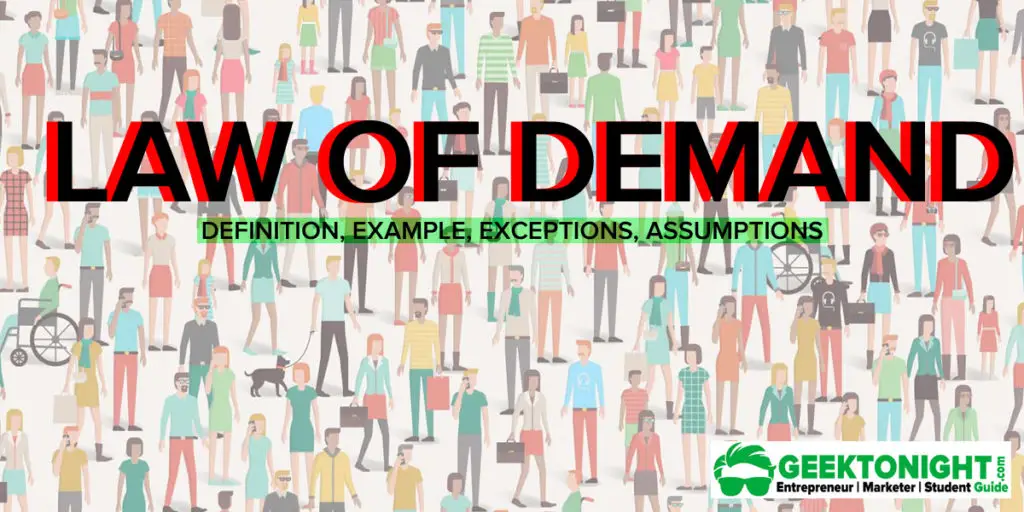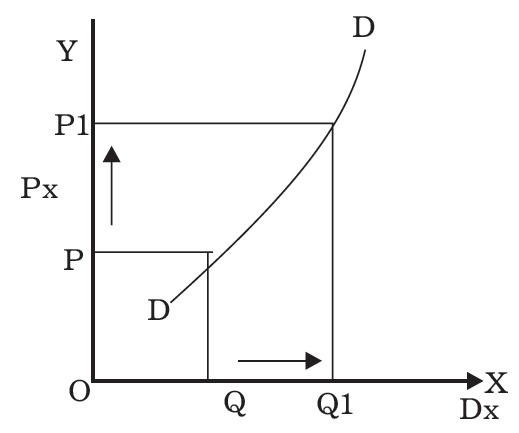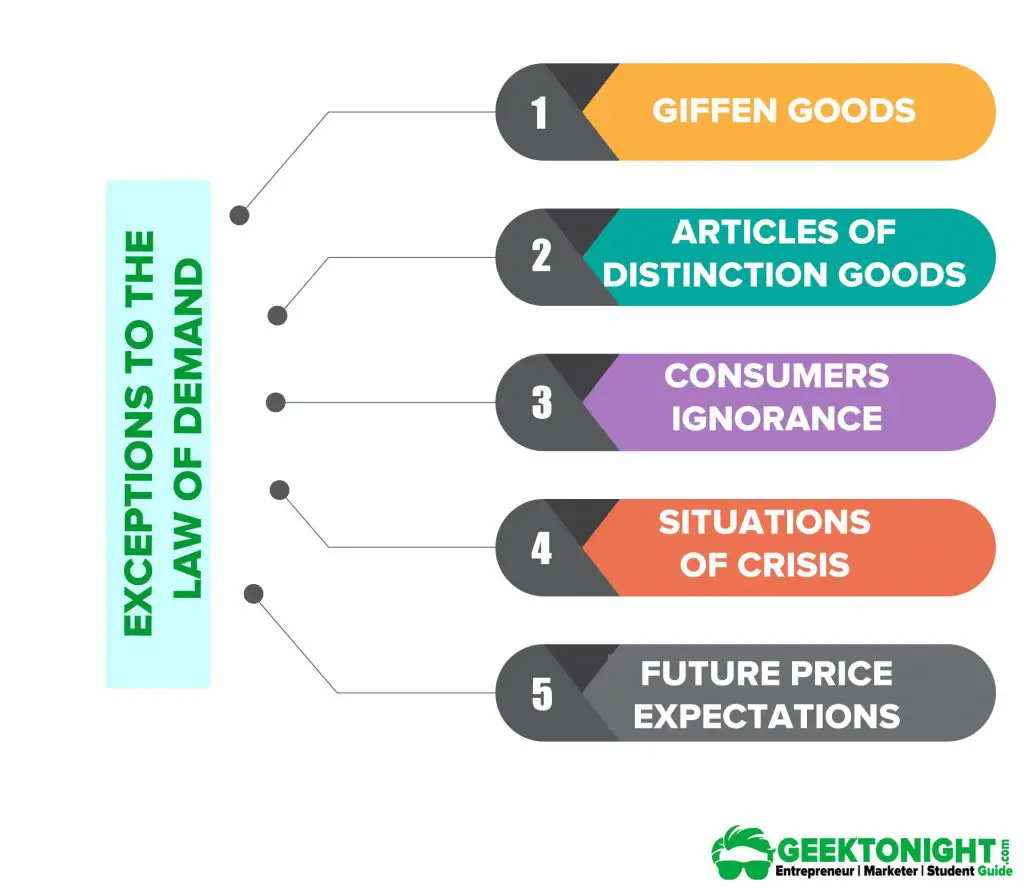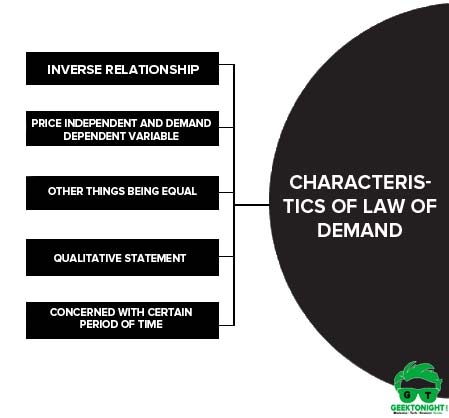What is the Law of Demand?
The law of demand is given as, “If the price of a product falls, its quantity demanded increases and if the price of the commodity rises, its quantity demanded falls, other things remaining constant.”

Table of Content [Show]
Law of Demand Example
Demand Example: Take the example of an individual, who needs to purchase soft drinks. In the market, a pack of three soft drinks is priced at ₹120 and the individual purchases the pack. In the next week, the price of the pack is reduced to ₹105. This time the individual purchases two packs of soft drinks. In the third week, the price of the pack has risen to ₹130.
This time the individual does not purchase the pack at all. It is a common observation that consumers purchase a commodity in greater quantities when its price is low and vice versa.
This inverse relationship between the demand and price of a commodity is called the law of demand.
Also Read: What is Economics?
Law of Demand Definition
The following are some popular definitions of the law of demand given by experts:
Robertson defines law of demand as “Other things being equal, the lower the price at which a thing is offered, the more a man will be prepared to buy it.”
Marshall defines law of demand as “The greater the amount to be sold, the smaller must be the price at which it is offered in order that it may find purchasers; or in other words, the amount demanded increases with a fall in price and diminishes with a rise in price.”
Ferguson defines law of demand as “Law of Demand, the quantity demanded varies inversely with price.”
Also Read: Types of Demand in Economics
Law of Demand Meaning
The law of demand represents a functional relationship between the price and quantity demanded of a commodity or service.
The law states that the quantity demanded of a commodity increase with a fall in the price of the commodity and vice versa while other factors like consumers’ preferences, level of income, population size, etc. are constant.
Demand is a dependent variable, while the price is an independent variable.
Therefore, demand is a function of price and can be expressed as follows:
D= f (P)
Where,
D= Demand
P= Price
f = Functional Relationship
Assumptions of Law of Demand
The law of demand follows the assumption of ceteris paribus, which means that the other factors remain unchanged or constant.
As mentioned earlier, the demand for a commodity or service not only depends on its price but also on several other factors such as price of related goods, income, and consumer tastes and preferences.
In the law of demand, other factors are assumed to remain constant while only the price of the commodity changes.
Following are the assumptions of law of demand:
- No expectation of future price changes or shortages
- No change in consumer’s preferences
- No change in the price of related goods
- No change in consumer’s income
- No change in size, age composition and sex ratio of the population
- No change in the range of goods available to the consumers
- No change in government policy
No expectation of future price changes or shortages
The law requires that the given price change for the commodity is a normal one and has no speculative consideration. That is to say, the buyers do not expect any shortages in the supply of the commodity in the market and consequent future changes in the prices. The given price change is assumed to be final at a time.
No change in consumer’s preferences
The consumer’s taste, habits and preferences should remain constant. 4. No change in the fashion: If the commodity concerned goes out the fashion the buyer may not buy more of it even at a substantial price is reduced.
No change in the price of related goods
Prices of other goods like substitutes and supportive, i.e., complementary or jointly demanded products remain unchanged. If the prices of other related goods change, the consumer’s preferences would change which may invalidate the law of demand.
No change in consumer’s income
Throughout the operation of the law, the consumer’s income should remain the same. If the level of a buyer’s income changes, he may buy more even at a higher price, invalidating the law of demand.
No change in size, age composition and sex ratio of the population
For the operation of the law in respect of total market demand, it is essential that the number of buyers and their preferences should remain constant. This necessitates that the size of population as well as the age structure and sex ratio of the population should remain the same throughout the operation of the law.
Otherwise, if the population changes, there will be additional buyers in the market, so the total market demand may not contract with a rise in price.
No change in the range of goods available to the consumers
This implies that there is no innovation and arrival of new varieties of product in the market which may distort consumer’s preferences.
No change in government policy
The level of taxation and fiscal policy of the government remains the same throughout the operation of the law. Otherwise, changes in income-tax, for instance, may cause changes in consumer’s income or commodity taxes and may lead to distortion in consumer’s preferences
The law of demand can be understood with the help of certain concepts, such as demand schedule, demand curve, and demand function.
Also Read: What is Business Economics?
Exception of Law of Demand
There are certain exceptions to the law of demand that with a fall in price, the demand also falls and there is an increase in demand with an increase in price.
In case of exceptions, the demand curve shows an upward slope and referred to as exceptional demand curve. Figure shows an exceptional demand curve:

Exception to law of demand refers to conditions where the law of demand is not applicable.
- Giffen goods
- Articles of distinction goods
- Consumers ignorance
- Situations of crisis
- Future price expectations

Giffen goods
Giffen good is a commodity that is unexpectedly consumed more as its price increases. Thus, it is an exception to the law of demand. In the case of Giffen goods, the income effect dominates over the substitution effect.
After the Irish Famine (1845), the potato crop failed due to plant disease, late blight, which destroys both the leaves and the edible roots, or tubers, of the potato plant. Due to this, the price of potatoes increased tremendously.
Despite the fact that the price increase made people to find substitutes of potatoes, they moved away from luxury products so that their overall consumption of potatoes increased.
Articles of distinction goods
Named after economist, Thorstein Veblen, these commodities satisfy the desires of the upper-class people in society. Veblen goods include those commodities whose demand is proportional to their price and thus, they are exceptions to the law of demand.
These articles are purchased only by a few rich people to feel superior to the rest. For example, diamonds, rare paintings, vintage cars, and antique goods are examples of Veblen goods.
Consumers ignorance
Consumer ignorance is another factor that motivates people to purchase a commodity at a higher price, which violates the law of demand. This results out of the consumer biases that a high-priced commodity is better in quality than a low-priced commodity.
Situations of crisis
Crisis such as war and famine negate the law of demand. During crisis, consumers tend to purchase in larger quantities with the purpose of stocking, which further accentuates the prices of commodities in the market. They fear that goods would not be available in the future.
On the other hand, at the time of depression, a fall in the price of commodities does not induce consumers to demand more.
Future price expectations
When consumers expect a rise in the prices of commodities, they tend to purchase commodities at existing high prices. For example, speculation of market strategists on an increase in gold prices in the future induces consumers to purchase higher quantities in order to stock gold.
On the contrary, if consumers expect a fall in the price of a commodity, they postpone the purchase for the future.
Also Read: Determinants of Demand
Characteristics of Law of Demand
The following are the main characteristics of law of demand:
- Inverse Relationship
- Price independent and Demand dependent variable
- Other things being equal
- Qualitative statement
- Concerned with certain period of time

Inverse Relationship
According to this law there is an inverse relationship between the quantity demanded and the price of a commodity. If the price of a commodity increases the quantity demanded decreases and if the price decreases the quantity demanded increases.
Price independent and Demand dependent variable
Price of a commodity is an independent variable. The law of demand explains the change in demand of a commodity due to change in its price. In mathematical terms price is an independent variable and demand is a dependent variable.
Other things being equal
This law holds good only when the other things remain the same. This ‘other things remaining the same’ is called the assumptions of the law of demand.
Qualitative statement
The law of demand is a qualitative statement which tells us that a fall in the price of a commodity will lead to an increase in the quantity demanded and a rise in price will lead to a fall in the quantity demanded. But it does not tell us how much change in price will bring how much change in quantity demanded.
Concerned with certain period of time
The law of demand is related with a particular period of time, for example weekly, monthly,
Leave a Reply